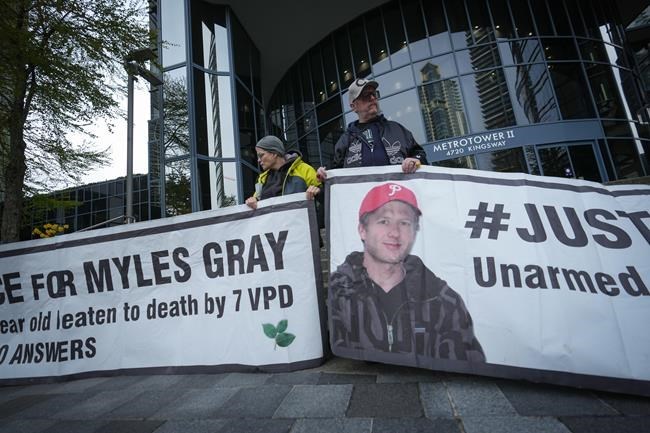BURNABY, B.C. — The jury in the British Columbia coroner's inquest into the death of Myles Gray nearly eight years ago won't be allowed to see a photo showing the man's injuries because the application was made too late, the coroner ruled Friday.
Larry Marzinzik said his view on admitting the photo would have been "very different" had the lawyer for Gray's family, Ian Donaldson, brought it up earlier.
Gray died in August 2015 after a beating by police that left him with injuries including ruptured testicles and fractures in his eye socket, nose, voice box and rib.
Marzinzik agreed with Donaldson that the photo would most likely have added value for the jury at the proper time, but not as the inquest was coming to a close.
There was no application for photos to be admitted before testimony from officers involved in the struggle to restrain Gray or first responders who tried to revive him.
Marzinzik heard arguments from Donaldson, as well as Crown counsel and lawyers for Vancouver police, who opposed the admission of the photo, before deciding there was no longer an opportunity for witnesses to provide context for the jury.
He said evidence of Gray's injuries have been well-documented for the jury through other materials and testimony.
Before outlining his decision not to allow the photo, Marzinzik told the inquest he was "torn between complete transparency and proper procedure."
Speaking to media on Friday, Gray's mother, Margie Gray, said the photo Donaldson wanted to show the jury was taken in the backyard where her son died.
She said procedure won over transparency in the coroner's decision, and suggested witnesses could have been called back to provide context for the photo.
Of the 14 Vancouver police officers who testified at the inquest, most said they didn't notice signs of injury besides redness on Gray's face and some bruising.
Several firefighters and paramedics told a different story, including one who said the bruising was so severe he initially thought Gray was not a white man.
Dr. Matthew Orde, the forensic pathologist who performed an autopsy on Gray, testified Thursday that a "perfect storm" of factors led to his death, including his extreme physical exertion and the actions of police to restrain him.
"What we can say with some degree of certainty ... is I don't think he would have died when he did had it not been for the police interaction on that day," Orde said.
The inquest heard Friday from a retired B.C. police officer turned trainer, Mike Massine, who testified as an expert in the use of force.
Critical incident and de-escalation training came into effect in B.C. in 2015, the year Gray died, although training has generally improved since then, he said.
Officers are taught to recognize signs of so-called "excited delirium" and they are told getting medical treatment for that person takes priority over any criminality, he said.
But Massine said getting the person to a hospital requires physical restraint.
Several of the officers involved in the struggle to restrain Gray told the inquest they believed he was experiencing excited delirium, saying he was sweating profusely, yelling nonsensically, and he seemed to have "superhuman strength."
However, Orde told the inquest this week that "acute behavioural disturbance" is a better term to describe what Gray was experiencing on the day he died.
On occasion, it was thought "so-called excited delirium syndrome" could result independently in death, the pathologist said.
"But I think critical analysis of the published data suggests that's probably quite unlikely," Orde testified. "I'm not persuaded that there's any good evidence that excited delirium syndrome can independently bring about death."
Orde pointed to police actions including "neck compression," blunt-force blows, the use of pepper spray, holding Gray on his stomach and handcuffing him behind his back as complicating factors in his death.
The inquest was expected to finish Friday after 10 days of testimony, but it was delayed over the debate about allowing the photo of Gray's injuries.
Supt. Shelley Horne, head of personnel services for the Vancouver Police Department, is the last person set to testify before the end of the inquest.
This report by The Canadian Press was first published April 28, 2023.
Brenna Owen, The Canadian Press



